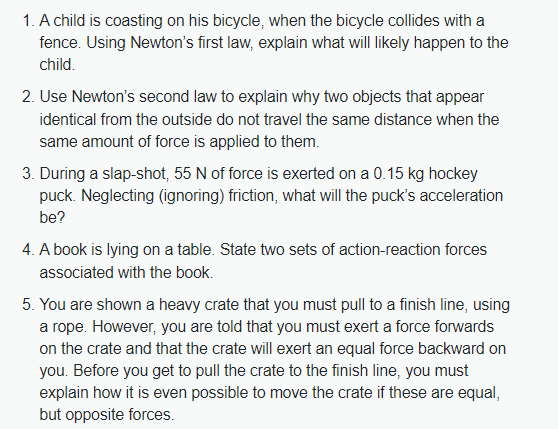1. A child is coasting on his bicycle, when the bicycle collides with a fence. Using Newton's first law, explain what will likely happen to the child.
1. A child is coasting on his bicycle, when the bicycle collides with a fence. Using Newton's first law, explain what will likely happen to the child.
College Physics
1st Edition
ISBN:9781938168000
Author:Paul Peter Urone, Roger Hinrichs
Publisher:Paul Peter Urone, Roger Hinrichs
Chapter4: Dynamics: Force And Newton's Laws Of Motion
Section: Chapter Questions
Problem 24PE: The wheels of a midsize car exert a force of 2100 N backward on the road to accelerate the car in...
Related questions
Topic Video
Question
Using your knowledge of Newton’s laws of motion, answer the following problems.

Transcribed Image Text:1. A child is coasting on his bicycle, when the bicycle collides with a
fence. Using Newton's first law, explain what will likely happen to the
child.
2. Use Newton's second law to explain why two objects that appear
identical from the outside do not travel the same distance when the
same amount of force is applied to them.
3. During a slap-shot, 55 N of force is exerted on a 0.15 kg hockey
puck. Neglecting (ignoring) friction, what will the puck's acceleration
be?
4. A book is lying on a table. State two sets of action-reaction forces
associated with the book.
5. You are shown a heavy crate that you must pull to a finish line, using
a rope. However, you are told that you must exert a force forwards
on the crate and that the crate will exert an equal force backward on
you. Before you get to pull the crate to the finish line, you must
explain how it is even possible to move the crate if these are equal,
but opposite forces.
Expert Solution
This question has been solved!
Explore an expertly crafted, step-by-step solution for a thorough understanding of key concepts.
This is a popular solution!
Trending now
This is a popular solution!
Step by step
Solved in 3 steps

Knowledge Booster
Learn more about
Need a deep-dive on the concept behind this application? Look no further. Learn more about this topic, physics and related others by exploring similar questions and additional content below.Recommended textbooks for you

College Physics
Physics
ISBN:
9781938168000
Author:
Paul Peter Urone, Roger Hinrichs
Publisher:
OpenStax College

Glencoe Physics: Principles and Problems, Student…
Physics
ISBN:
9780078807213
Author:
Paul W. Zitzewitz
Publisher:
Glencoe/McGraw-Hill

University Physics Volume 1
Physics
ISBN:
9781938168277
Author:
William Moebs, Samuel J. Ling, Jeff Sanny
Publisher:
OpenStax - Rice University

College Physics
Physics
ISBN:
9781938168000
Author:
Paul Peter Urone, Roger Hinrichs
Publisher:
OpenStax College

Glencoe Physics: Principles and Problems, Student…
Physics
ISBN:
9780078807213
Author:
Paul W. Zitzewitz
Publisher:
Glencoe/McGraw-Hill

University Physics Volume 1
Physics
ISBN:
9781938168277
Author:
William Moebs, Samuel J. Ling, Jeff Sanny
Publisher:
OpenStax - Rice University
